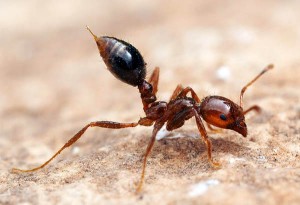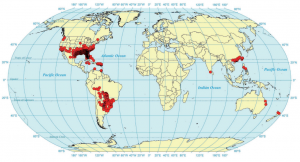After a lengthy wait in line for a basket of tortilla chips, I seated myself at an outside picnic table and eagerly awaited my order of this planet’s finest queso. My eyes periodically swung toward the door in anticipation, and after a few more minutes of hunger pangs, my troubles were soon to be ended. A steaming bowl of cheesy gold was delivered down from the heavens, and without delay, I reached for a crispy, brown triangle to be the one to carry this divine substance into my mouth. But before I could even come close to biting down, a sudden, sharp pain shot down from the back of my hand, and I dropped the heaven-sent queso right onto my white shorts. Ignoring the sounds of laughter erupting around me, I searched for the culprit, and there it was. Curled up innocently like a dog that did something it knew it wasn’t supposed to, a large red fire-ant was caught in between a few hairs on my hand. Without a tinge of regret, I angrily flicked the shorts-ruiner into oblivion.
But right after doing so, I thought to myself, “That little bug was probably left unscathed wasn’t she.” Small insects like ants fare just fine when subjected to forces, when scaled up, would utterly annihilate your average human. And I knew the culprit was a ‘she’ from what I remembered from biology: fertilized eggs produce females, often workers, and unfertilized eggs produce males, the rare ones who serve only a reproductive role. I also knew this was a red imported fire-ant, because anyone who’s ever played in a playground in Texas is uncomfortably familiar with this feisty invasive species of ant. I then asked myself, my shorts still covered in yellow goo, “What is it that makes this fire ant so darn good at spreading?”
 After getting back to dorm that day, I changed into something less Tex-Mex-laden, and then logged into my computer to find out a bit more about this particular ant species. Originating from South America, this hymenopteran is said to have been introduced to the United States on a cargo ship arriving in Alabama between 1933 and 1945. Given the number of decades between its ecological introduction and the present day, it is understandable that the fire ant has had some time to spread. But seeing how far north and west this tiny creature has expanded in just a little over half a century is truly remarkable within this arguably small timeframe, which is a mere snapshot of the species’ long history.
After getting back to dorm that day, I changed into something less Tex-Mex-laden, and then logged into my computer to find out a bit more about this particular ant species. Originating from South America, this hymenopteran is said to have been introduced to the United States on a cargo ship arriving in Alabama between 1933 and 1945. Given the number of decades between its ecological introduction and the present day, it is understandable that the fire ant has had some time to spread. But seeing how far north and west this tiny creature has expanded in just a little over half a century is truly remarkable within this arguably small timeframe, which is a mere snapshot of the species’ long history.
The network of highways and roads of this interconnected country have likely played a large role in the terrestrial spread of the red imported fire ant, or RIFA, which would have otherwise been less able to spread at such a remarkable rate. These resourceful creatures have been found to travel long distances when newly-mated queens land on cars, trucks or trains. As a result, RIFA has been steadily growing in Texas since arriving here in the 1950’s and is now considered to be among the worst invasive species in the world. Referred to as Solenopsis invicta, this member of the Formicidae family, the notorious insect causes nearly $5 billion in damages (the majority for medical treatment and some even property damage) according to the FDA. The most direct consequences for humans are for the unfortunate individuals who are hypersensitive to the ant’s venom, which causes anaphylaxis in some rare cases. More indirect effects range from ant-related damages to electrical equipment all the way to potentially fatal pet stings for household dogs and cats. More than $250 million has been spent to control and eradicate them, with numbers only increasing in recent years. However, most of these eradication attempts have been ineffective. The specific epithet of this RIFA, invicta, aptly comes from Latin for “invincible.”
So beyond the ability to travel alongside humans, is there potentially something else that fire ants are equipped with which allows them to seemingly violate the concept of ecological niche, and  spread so rapidly? While this blog won’t be able solve this question in just a few short paragraphs, we can take a closer look at certain qualities that make this ant special, beginning with this ant’s distinguishing trait–it’s “fiery” venom. This piperidine-based substance plays an important role in RIFA colonies and is used to capture prey, as well as in defense and antimicrobial action, and may be just one reason for the species’ success over indigenous counterparts. More fascinatingly, these ants also display an incredible amount of resilience in terms of their behaviors in response to environmental conditions. They have adapted ways to sense increases in water levels and respond by linking together to form live, floating rafts with workers on the outside and queens on the inside. This adaptation is invaluable in a city like Houston which quickly and unexpectedly turns from desert to ocean overnight. This preliminary look into the species barely scratches the surface of the incredible scientific findings in recent years. For more information on this destructive critter, the following PBS video provides an informative rundown of the red fire ant: https://www.youtube.com/watch?v=rz3UdLEWQ60.
spread so rapidly? While this blog won’t be able solve this question in just a few short paragraphs, we can take a closer look at certain qualities that make this ant special, beginning with this ant’s distinguishing trait–it’s “fiery” venom. This piperidine-based substance plays an important role in RIFA colonies and is used to capture prey, as well as in defense and antimicrobial action, and may be just one reason for the species’ success over indigenous counterparts. More fascinatingly, these ants also display an incredible amount of resilience in terms of their behaviors in response to environmental conditions. They have adapted ways to sense increases in water levels and respond by linking together to form live, floating rafts with workers on the outside and queens on the inside. This adaptation is invaluable in a city like Houston which quickly and unexpectedly turns from desert to ocean overnight. This preliminary look into the species barely scratches the surface of the incredible scientific findings in recent years. For more information on this destructive critter, the following PBS video provides an informative rundown of the red fire ant: https://www.youtube.com/watch?v=rz3UdLEWQ60.
Sources:
- Lofgren, C.S. (1985). The economic importance and control of imported fire ants in the United States. pp. 227-256. In Economic Impact and Control of Social Insects
- Red Imported Fire Ant, Entomology, University of Florida: http://entnemdept.ufl.edu/creatures/urban/ants/red_imported_fire_ant.htm
- Texas Imported Fire Ant Research Management Project, Texas A&M AgriLife Extension: https://fireant.tamu.edu/learn/history-of-the-red-imported-fire-ant/
- Triplehorn, C.A. & Johnson, N.F. (2005). Borror and DeLong’s Introduction to the Study of Insects. Belmont, CA: Thomson Brooks/Cole.
- Vinson, S.B. & A.A. Sorenson (1988). Imported Fire Ants: Life History and Impact. Texas Department of Agriculture, Austin, Texas. 28 pp.
- Wetterer, James (2008). Ant Spread Map, Wikimedia Commons




